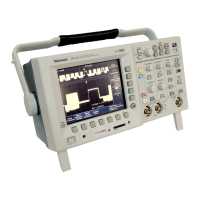Reference
FFT window Characteristics Best for m easuring
Blackman-Harris Best magnitude,
worst at resolving
frequencies.
Predominantly single frequency
waveforms to look for higher
order harmonics.
Hamming,
Hanning
Better frequency,
poorer magnitude
accuracy than
Rectangular.
Hamming has
slightly better
frequency resolution
than Hann ing.
Sine, p eriodic, and
narrow-band random noise.
Transients or bursts where
the signal levels before and
after the event are significantly
different.
Rectangular
Best fre quency,
worst magnitude
resolution. This is
essentially the same
as no window.
Transients or bursts where the
signal levels before and after
the event are nearly equal.
Equal-amplitude sine waves
with frequencies that are very
close.
Broad-band random noise
with a relatively slow varying
spectrum.
Aliasing. Problem s occur when the oscilloscope acquires a signal
containing freq uency components that are g reater than the Nyquist
frequency (1/2 the sample rate). The frequency com ponents that are
above the N yq uist frequency are undersampled and appear to "fold
back" around the right edge o f the graticule, showing as lower frequency
components in the FFT waveform. These incorrect components are
called aliases.
92 TDS3000C Series Oscilloscope User Manual
